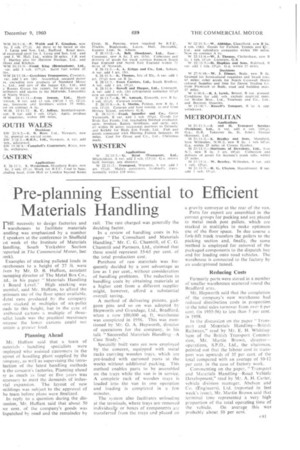Pre-planning Essential to Efficient Materials Handling
Page 77

If you've noticed an error in this article please click here to report it so we can fix it.
fHE necessity to design factories and warehouses to facilitate materials andling was emphasized by a number f speakers at the conference in Sheffield 1st week of the Institute of Materials fandling, South Yorkshire Section reported in Tire Commercial Motor, last reek).
Examples of stacking palleted loads in arehouses to a height of 27 ft. were iven by Mr, D. B. Huffam, assistant aanaging director of The Metal Box Co., Ad,. in his paper " Materials Handling t Board Level." High stacking was ssential, said Mr. Huffam, to afford the qatimum use of the floor space available. detal cans produced by the company were stacked in multiples of six-pallet oads to this height, but in the case of ardboard cartons a multiple of threetallet loads was the practical maximum tccause the lower cartons could not ustain a greater load.
Planning Ahead
Mr. Huffam said that a team of aaterials handling specialists were !mployed who assisted customers in the ayout of handling plant supplied by the :ompany, as well as supervising the introluetion of the latest handling methods n the concern's factories. Planning ahead ■ !,r as much as four or five years was tecessary to meet the demands of indusrial expansion. The layout of new windings was subject to the approval of he team before plans were finalized.
In reply to a question during the.disaission, Mr. Huffarn said that about 50
■ er cent, of the company's goods was lispatched by road and the remainder by rail. The rate charged was generally the deciding factor.
In a review of handling costs in his paper " The Consultant and Materials Handling," Mr. C. G. Chantrill, of C. G. Chantrill•and Partners, Ltd., claimed that these could represent 55-65 per cent, of the total production cost.
Purchase of raw materials was frequently decided by a cost advantage as low as 1 per cent., without consideration of handling problems. The reduction in handling costs by obtaining materials at a higher cost from a different supplier might, however, afford a substantial overall saving.
A method of delivering pistons, gudgeon pins and so on was adopted by Hepworth and Grandage, Ltd., Bradford, when a new 100,000 sq, ft, warehouse was completed in 1956. This was mentioned by Mr. G. A. Hepworth, director of operations for the company, in his talk "Successful Materials Handling A Case Study."
Specially built vans are now employed by the concern, equipped with metal racks carrying wooden trays, which are pre-loaded with cartoned parts at the works without additional packing. This method enables parts to be assembled on the trays while the van is in service, A complete rack of wooden trays is loaded into the van in one operation and loading is completed in a few minutes.
The system also facilitates unloading at the terminals, where trays are removed individually or boxes of components are transferred from the trays and placed on a gravity conveyor at the rear of the van.
Parts for export are assembled in the correct groups for packing and are placed in metal mesh post pallets, which are stacked in multiples to make optimum use of the floor space. In due course a fork-lift truck transfers the pallets to the packing section and, finally, the same method is employed for removal of the packaged components to the dispatch bay and for loading onto road vehicles. The warehouse is connected to the factory by an underground tunnel.
Reducing Costs
Formerly parts were stored in a number of smaller warehouses scattered round the Bradford area.
Mr. Hepworth said that the completion of the company's new warehouse had reduced distribution costs in proportion to the total sales turnover from over 6 per cent. (in 1955-56) to less than 5 per cent, in 1958.
In the discussion on the paper " Transport and Maicrials Handling—British Railways," read by Mr. E. H. Winningham of the British Transport Commission, Mr. Martin Brown, director-operations, S.P.D., Ltd., the chairman, pointed out that the labour cost ill transport was upwards of 35 per cent. of the total compared with an average of 10-12 per cent. in the case of factory work.
Commenting on the paper, "Transport and Materials Handling—Road Vehicle Development," read by Mr. A, H. Carter, vehicle division manager, Abelson and Co. (Engineers), Ltd. (reported in last week's issue), Mr. Martin Brown said that terminal time represented a very high proportion of the total operating time of the vehicle. On average this was probably about 50 per cent..
























































































































